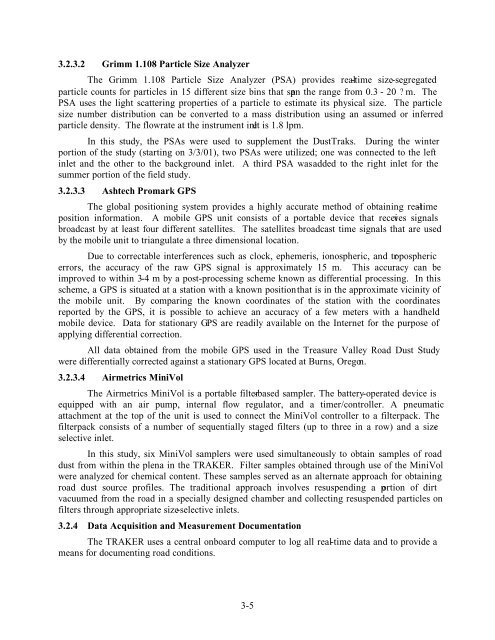treasure valley road dust study: final report - ResearchGate
treasure valley road dust study: final report - ResearchGate
treasure valley road dust study: final report - ResearchGate
You also want an ePaper? Increase the reach of your titles
YUMPU automatically turns print PDFs into web optimized ePapers that Google loves.
3.2.3.2 Grimm 1.108 Particle Size Analyzer<br />
The Grimm 1.108 Particle Size Analyzer (PSA) provides real-time size-segregated<br />
particle counts for particles in 15 different size bins that span the range from 0.3 - 20 ?m. The<br />
PSA uses the light scattering properties of a particle to estimate its physical size. The particle<br />
size number distribution can be converted to a mass distribution using an assumed or inferred<br />
particle density. The flowrate at the instrument inlet is 1.8 lpm.<br />
In this <strong>study</strong>, the PSAs were used to supplement the DustTraks. During the winter<br />
portion of the <strong>study</strong> (starting on 3/3/01), two PSAs were utilized; one was connected to the left<br />
inlet and the other to the background inlet. A third PSA was added to the right inlet for the<br />
summer portion of the field <strong>study</strong>.<br />
3.2.3.3 Ashtech Promark GPS<br />
The global positioning system provides a highly accurate method of obtaining real -time<br />
position information. A mobile GPS unit consists of a portable device that receives signals<br />
b<strong>road</strong>cast by at least four different satellites. The satellites b<strong>road</strong>cast time signals that are used<br />
by the mobile unit to triangulate a three dimensional location.<br />
Due to correctable interferences such as clock, ephemeris, ionospheric, and tropospheric<br />
errors, the accuracy of the raw GPS signal is approximately 15 m. This accuracy can be<br />
improved to within 3-4 m by a post-processing scheme known as differential processing. In this<br />
scheme, a GPS is situated at a station with a known position that is in the approximate vicinity of<br />
the mobile unit. By comparing the known coordinates of the station with the coordinates<br />
<strong>report</strong>ed by the GPS, it is possible to achieve an accuracy of a few meters with a handheld<br />
mobile device. Data for stationary GPS are readily available on the Internet for the purpose of<br />
applying differential correction.<br />
All data obtained from the mobile GPS used in the Treasure Valley Road Dust Study<br />
were differentially corrected against a stationary GPS located at Burns, Oregon.<br />
3.2.3.4 Airmetrics MiniVol<br />
The Airmetrics MiniVol is a portable filter-based sampler. The battery-operated device is<br />
equipped with an air pump, internal flow regulator, and a timer/controller. A pneumatic<br />
attachment at the top of the unit is used to connect the MiniVol controller to a filterpack. The<br />
filterpack consists of a number of sequentially staged filters (up to three in a row) and a sizeselective<br />
inlet.<br />
In this <strong>study</strong>, six MiniVol samplers were used simultaneously to obtain samples of <strong>road</strong><br />
<strong>dust</strong> from within the plena in the TRAKER. Filter samples obtained through use of the MiniVol<br />
were analyzed for chemical content. These samples served as an alternate approach for obtaining<br />
<strong>road</strong> <strong>dust</strong> source profiles. The traditional approach involves resuspending a portion of dirt<br />
vacuumed from the <strong>road</strong> in a specially designed chamber and collecting resuspended particles on<br />
filters through appropriate size-selective inlets.<br />
3.2.4 Data Acquisition and Measurement Documentation<br />
The TRAKER uses a central onboard computer to log all real-time data and to provide a<br />
means for documenting <strong>road</strong> conditions.<br />
3-5
















